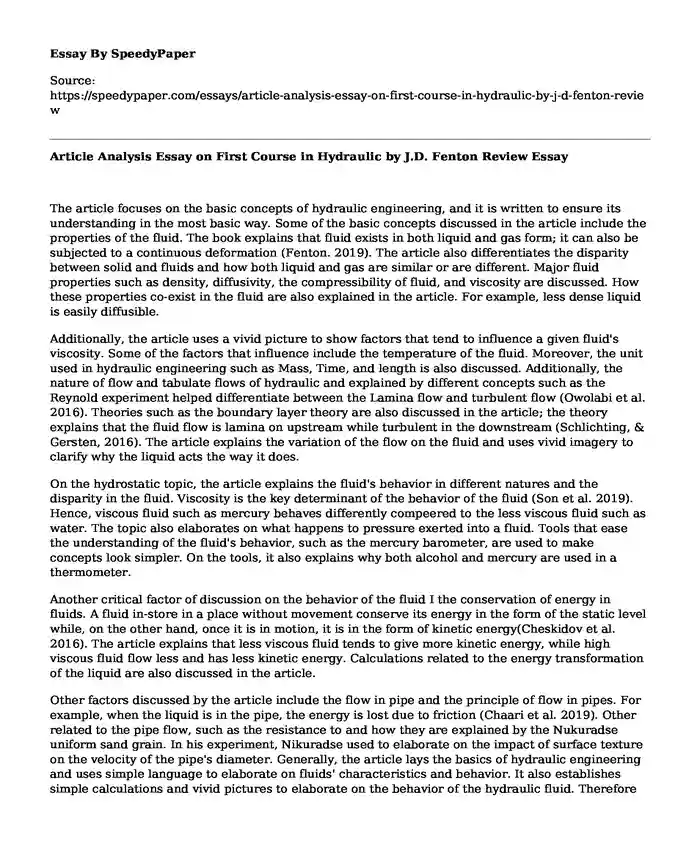
| Type of paper: | Essay |
| Categories: | Engineering |
| Pages: | 3 |
| Wordcount: | 734 words |
The article focuses on the basic concepts of hydraulic engineering, and it is written to ensure its understanding in the most basic way. Some of the basic concepts discussed in the article include the properties of the fluid. The book explains that fluid exists in both liquid and gas form; it can also be subjected to a continuous deformation (Fenton. 2019). The article also differentiates the disparity between solid and fluids and how both liquid and gas are similar or are different. Major fluid properties such as density, diffusivity, the compressibility of fluid, and viscosity are discussed. How these properties co-exist in the fluid are also explained in the article. For example, less dense liquid is easily diffusible.
Additionally, the article uses a vivid picture to show factors that tend to influence a given fluid's viscosity. Some of the factors that influence include the temperature of the fluid. Moreover, the unit used in hydraulic engineering such as Mass, Time, and length is also discussed. Additionally, the nature of flow and tabulate flows of hydraulic and explained by different concepts such as the Reynold experiment helped differentiate between the Lamina flow and turbulent flow (Owolabi et al. 2016). Theories such as the boundary layer theory are also discussed in the article; the theory explains that the fluid flow is lamina on upstream while turbulent in the downstream (Schlichting, & Gersten, 2016). The article explains the variation of the flow on the fluid and uses vivid imagery to clarify why the liquid acts the way it does.
On the hydrostatic topic, the article explains the fluid's behavior in different natures and the disparity in the fluid. Viscosity is the key determinant of the behavior of the fluid (Son et al. 2019). Hence, viscous fluid such as mercury behaves differently compeered to the less viscous fluid such as water. The topic also elaborates on what happens to pressure exerted into a fluid. Tools that ease the understanding of the fluid's behavior, such as the mercury barometer, are used to make concepts look simpler. On the tools, it also explains why both alcohol and mercury are used in a thermometer.
Another critical factor of discussion on the behavior of the fluid I the conservation of energy in fluids. A fluid in-store in a place without movement conserve its energy in the form of the static level while, on the other hand, once it is in motion, it is in the form of kinetic energy(Cheskidov et al. 2016). The article explains that less viscous fluid tends to give more kinetic energy, while high viscous fluid flow less and has less kinetic energy. Calculations related to the energy transformation of the liquid are also discussed in the article.
Other factors discussed by the article include the flow in pipe and the principle of flow in pipes. For example, when the liquid is in the pipe, the energy is lost due to friction (Chaari et al. 2019). Other related to the pipe flow, such as the resistance to and how they are explained by the Nukuradse uniform sand grain. In his experiment, Nikuradse used to elaborate on the impact of surface texture on the velocity of the pipe's diameter. Generally, the article lays the basics of hydraulic engineering and uses simple language to elaborate on fluids' characteristics and behavior. It also establishes simple calculations and vivid pictures to elaborate on the behavior of the hydraulic fluid. Therefore this article can be used by the student to create the base of hydraulic engineering.
References
Cheskidov, A., Lopes Filho, M. C., Lopes, H. N., & Shvydkoy, R. (2016). Energy conservation in two-dimensional incompressible ideal fluids. Communications in Mathematical Physics, 348(1), 129-143.
Chaari, M., Fekih, A., Seibi, A. C., & Ben Hmida, J. (2019). A Generalized Reduced-Order Dynamic Model for Two-Phase Flow in Pipes. Journal of Fluids Engineering, 141(10).
Fenton. J. D. (2019). A First Course in Hydraulics. Institute of Hydraulic Engineering and Water Resources Management Vienna University of Technology, Karlsplatz 13/222,
Owolabi, B. E., Poole, R. J., & Dennis, D. J. (2016). Experiments on low-Reynolds-number turbulent flow through a square duct. Journal of Fluid mechanics, 798, 398-410.
Schlichting, H., & Gersten, K. (2016). Boundary-layer theory. Springer. https://cds.cern.ch/record/2240520Son, B. G., Lee, H. S., Lee, Y. J., & Han, D. Y. (2019). Fluidity Performance Evaluation of Low Viscosity Typed Superplasticizer for Cement-Based Materials Incorporating Supplementary Cementitious Materials. Journal of the Korea Institute of Building Construction, 19(3), 219-228.
Cite this page
Article Analysis Essay on First Course in Hydraulic by J.D. Fenton Review. (2023, Sep 17). Retrieved from https://speedypaper.net/essays/article-analysis-essay-on-first-course-in-hydraulic-by-j-d-fenton-review
Request Removal
If you are the original author of this essay and no longer wish to have it published on the SpeedyPaper website, please click below to request its removal:
- How Democratic was Jacksonian Democracy?
- Education Essay Sample: A Reading Task That Is Difficult for Me
- Free Essay Sample on Green Mark Platinum Award
- Essay Sample: Compassion in Undermining Political Suffering and Politically Achieved Rights
- Free Essay Example - Craft of Writing
- Essay Sample on Plastic Usage as a Social Problem
- Big Data Benefits, Challenges, and Strategies to Mitigate Risks in Healthcare - Report Example
Popular categories




